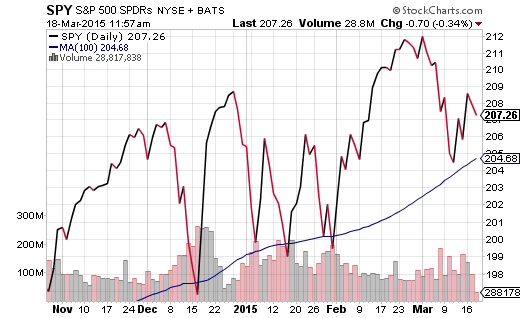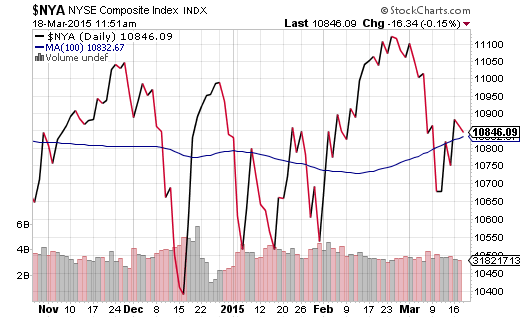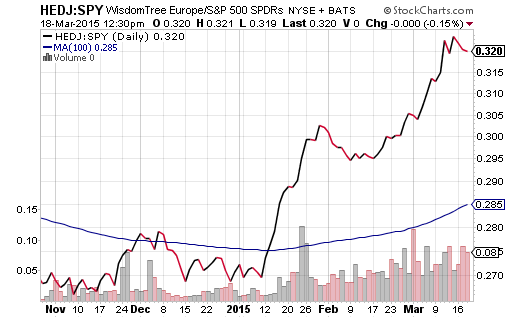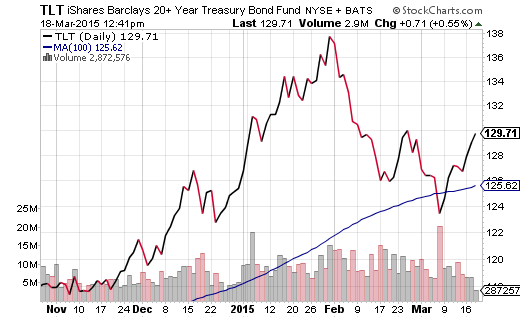A large number of stocks in the Dow Jones 30 Average have moved lower since the Federal Reserve ended its quantitative easing (QE) program in late October. Telecom giants AT&T (NYSE:T) and Verizon (NYSE:VZ) have toiled. Consumer champs Procter & Gamble (NYSE:PG) and Coca-Cola (NYSE:KO) have struggled. Commodity-related kings like Chevron (NYSE:CVX) and Caterpillar (NYSE:CAT)? They’ve been obliterated.
In fact, nearly half of the 30 components (13) have lost ground since the Fed stopped acquiring billions in assets with electronically created money. One might expect the Dow to have had trouble appreciating in value with that sort of drag. However, the Dow is a price-weighted index. It follows that stocks with higher prices exert more influence on the index as a whole and, by extension, can keep bull market perceptions intact.
How might the picture look different if the components had equal weighting? It might look similar to the Elements Dogs of the Dow ETN (DOD). While DOD actually tracks the Dow Jones High Yield 10 Index – not the entire Dow 30 – each component receives the same weight upon annual selection. A chart of DOD gives one an idea of how flagship stocks might actually be faring in a post-QE environment.
Not convinced? So 13 of 30 components are falling, who cares? Then take a look at the broadest measure of stock performance in the NYSE Composite. Let’s compare it to the (ARCA:SPY), where the weighting is concentrated in some of the top market-capitalization leaders.
The SPY has continued to appreciate.
Meanwhile, the entire list of common stocks that trade on the New York Stock Exchange are not exactly knocking it out of the park since the end of QE.
What it really comes down to is the reality that the removal of QE has had the effect of monetary tightening. Worse yet, it has come at a time when the rest of the globe is aggressively easing. That dynamic has sent the U.S. dollar to remarkable highs while, simultaneously, the median stock P/E and median stock P/S are already sporting record valuations. With the ultra-strong dollar only able to hamper exports and corporate profit potential earned in foreign currencies, record valuations will move even further into the stratosphere.
What does all of this imply? First, regardless of how “patient” or “impatient” Yellen’s Fed becomes, they’ll have to walk a proverbial tightrope. Specifically, in trying to raise overnight lending rates at some point in 2015, they will still need to convince market participants that their policies still represent monumental accommodation. If they are persuasive, stocks may still find a way to climb. If participants get anxious, U.S. stocks will pull back significantly. You might even benefit from employing a multi-asset approach to stock hedging.
Second, the enormous popularity of QE-inspired investing can be seen in the WisdomTree Europe Hedged Equity HEDJ:SPY price ratio. Foreign developed stocks had been left to gluttons for punishment since 2011. Now that the euro has been trashed in the ongoing currency wars – now that the European Central Bank (ECB) is buying whatever euro-zone debt it can find – investors are clamoring for currency-hedged foreign assets. All of the momentum is with HEDJ over SPY.
Finally, in spite of clearly-defined deceleration in the U.S. economy, the euro-zone is in far worse shape. And yet, one can pursue nearly 200 basis points (2%) more in yield with the U.S. 10-Year than with Germany’s sovereign instrument. If current circumstances around the globe were not being distorted by currency wars, interest rate manipulation and/or electronic money creation, the interest rate disparity would be indicating dollar weakness versus euro strength. The opposite is true today, and it is likely to continue for the intermediate term.
It follows that one should expect institutions and worldwide money managers to seek relative value in US-dollar-denominated government bonds. At least for the next 12-18 months, one should be rewarded for buying the dips in U.S. treasuries. I have been doing so with (NYSE:TLH) as well as (ARCA:TLT). Remember, absent asset purchases in quantitative easing, the Federal Reserve only controls the front-end of the yield curve. In other words, short-term rates might move a bit higher, but long-term rates are likely to fall and the yield curve is likely to flatten.






